Introduction:
The curriculum design context of our project centers around the specifics of our team’s proposed course curriculum. Our team designed this curriculum as a culmination of the research and outreach discussed in our social and political analyses. Through our outreach process, we aimed to further understand Lafayette’s wants and needs for a community-centric engineering course. This outreach included an engineering student survey, an engineering professor survey, and an observationally-based analysis of a mechanical engineering community engaged senior design course. We reviewed a series of successful community-centric engineering curricula at other institutions to guide the curriculum for Lafayette College such as two relevant minors at the Colorado School of Mines, one of the leading institutions with regards to community-centric design. We also researched the baseline practices of engineering ethics to guide our curriculum. This input, in conjunction with our research, helped us to discover the necessary Lafayette-specific components for our proposed course. Furthermore, the course is guided by the principles of Sustainable Community Development (SCD) and ethical engineering practices.
To read this full subsection read below or click:Curriculum Design Context
Stakeholder Outreach:
We used student and faculty surveys to gauge the manifestations of engineering culture at Lafayette and to gain a better understanding of how our engineers feel connected with, or disconnected from, the community. We sought to identify the non-technical components our engineering professors and students feel they are teaching or being taught, respectively. The results of each survey are detailed below.
Use the links below to access the surveys.
Student Survey Results:
Our student survey generated 34 responses, representing all majors within the engineering department. Of the students surveyed, a majority were juniors and seniors, as these students have a better understanding of their undergraduate education at Lafayette. We conducted most of the student survey orally, while the faculty survey was electronically administered to the engineering professors. Figure 1 shows the distribution of respondents for the student survey.
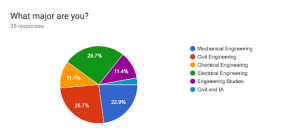
Figure 1. Distribution of majors for student survey. This figure illustrates the percentage of students surveyed within each engineering major.
The first question of the student student survey asked: “do you feel that as an engineer you have an impact on the community?” “Community” was defined as the people that are affected by the respondents’ engineering designs. Respondents were asked to rate their current impact as well as their expected professional impact on the community. The respondent was given a scale from one (1) to five (5), where one represented no impact on the community while five represented a strong impact on the community. After providing a numerical answer, we asked the respondent to elaborate on their response to gauge a deeper understanding of “why” and allow them to explain if they felt there was a discrepancy between the current state and future state of their impact. In total, 88.2% of the engineering students surveyed responded with a ranking of three or higher, indicating they feel they will have an impact on the community. More specifically, 58.2% of respondents ranked their impact as a four or a five meaning they perceive they have and will have a strong impact on the community. Figure 2 below shows the specific distribution of responses to this question.
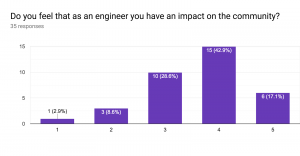
Figure 2. Question 1 of student survey. This figure represents the responses to the first question in the student survey: Do you feel that as engineer you have an impact on the community? One (1) indicates no impact and five (5) indicates a strong impact.
When asked to explain, respondents’ answers began to exhibit a gap between engineering students’ expect impact in the professional world and what they learn through Lafayette’s engineering curriculum. One conclusion we drew based on the large number of the responses was that students “know” that as engineers in the professional world they will be in a position to directly impact communities. This response corresponded with the high ratings given in response to the first question. However, in their current position as undergraduate students, they do not feel that they have enough experience or exposure to their potential impact. Some examples of these responses are illustrated below:
- “Here at Lafayette, I feel like you have no impact on the community. However, in the real world, I believe that my career choice will have a huge impact on the community”
- “I feel that at some point I will have an impact at some point but I’m still in college”
- “I think that presently I do not have an impact on the community. However, in the future, I believe that I will be able to have a very large impact.”
- “I feel like to get a good grasp on that I would have to test it out, which I have yet to do, but I think I could find a job where I could impact the community.”
Many of the respondents’ additional comments were similar to those listed above, illustrating that engineering students notice a gap in Lafayette’s engineering curriculum. Our students are graduating with the knowledge that they will have an impact on people and communities, but without the interdisciplinary experience or training to properly approach that impact. The students who saw their direct impact on community, gained this perspective through internships and research opportunities. This disconnect between how we are preparing our engineers to impact communities and how they expect to impact communities is the gap this proposed course attempts to bridge with a focus on SCD and ethics. Ideally, this class will help students understand how engineers impact communities and encourage them to start to see the impacts that their projects and designs have on local and global communities.
The second part of our survey focused on gauging the technical skills Lafayette engineers perceive they are learning from Lafayette’s program. We asked our participants to “list their top 3 non-technical skills that they feel they have developed/refined through Lafayette’s engineering program”. Many of our Bachelor of Science program engineers struggled to list 3 non-technical skills, often responding with long pauses and comments like “ugh this is hard” or “I don’t have any skills.” While the second comment was meant for comedic effect, these long pauses and inability to readily list non-technical skills show a need to emphasize the importance of non-technical skills in our classrooms. The word cloud in Figure 3 depicts the responses provided for this question. Words that are larger correlate to the words’ respective appearance in a greater number of responses.
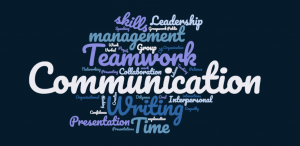
Figure 3. Word cloud of non-technical skills in student survey. This figure depicts what Lafayette College engineering students believe to be their strongest non-technical skills.
Additionally, it is important to note that 41% of the non-technical skills given included the specific words such as teamwork, communication, and writing skills. While these are important skills for engineers to develop, there are much more important non-technical skills that should be more prevalent in students’ answers. Lucena et. al describes the important non-technical skills that are crucial to understanding end-user needs and community needs. These skills mentioned in his book include active listening, empathy, thinking creatively, and understanding different perspectives (Lucena et. al, 2010). Our proposed course will give our students the opportunity to learn and realize the importance of these specific non-technical skills in engineering. Utilizing this information, students can actively use these skills during future projects which will then strengthen the engineers that we are producing from Lafayette.
Faculty Survey Results
To gain a holistic view of the culture within the Lafayette Engineering division, we conducted a survey with twenty two professors with a balanced amount of perspectives from each department. 70% of the faculty surveyed have served at the College for at least five years. The survey focused questions around their personal views on community and their incorporation of community and non-technical skills in their teaching. Considering professors’ variety of experiences, we attempted to keep questions equitable between ratings and open-ended questions. Figure 4 shows the distribution of respondents across the engineering departments for the faculty survey.
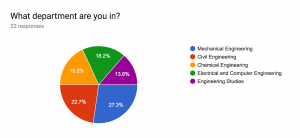
Figure 4. Distribution of departments for faculty survey. This figure illustrates the percentage of faculty we surveyed in each engineering department.
Overall, questions surrounding community-engagement that focused on faculty’s teaching and academic research provided insight into the faculty’s perceptions of community. They received a greater range of varied responses than questions about non-technical skills. The question: “Does community-centric design play a role in your teaching? If so, how?” was one of the most explicit questions about their community impact on the survey. Five professors said it does not play a role in their teaching while the rest saw a general connection to an end-product user as a defined community. 60% of professors who responded yes taught either a 400-level engineering course (mainly senior design projects) or an Engineering 101 course. These courses are mainly project-based with a less rigid course structure. Project-based courses allow for flexibility in methods of teaching and evaluation of relevant skills. Also, most research conducted about community-centric engineering education are structured through a project-based approach rather than lecture-based. (2014 International Conference on Interactive Collaborative Learning (ICL), 2014,414)
The responses to the following two questions: “As an engineer, do you feel that you have an impact on the community? (the community that you design/ research for)” and “As an engineer, do you feel closely linked to the community in which you design/research for?” were closely correlated. 60% of participants felt that they have a fairly strong impact on the community and 50% felt they are closely linked to the community in which they design/research for. Figure 5 and Figure 6 display these results below.
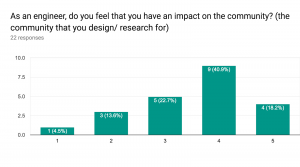
Figure 5. Faculty responses to “As an engineer, do you feel that you have an impact on the community? (the community that you design/ research for). This figure displays Lafayette engineering faculty’s level of influence on the community they design for.
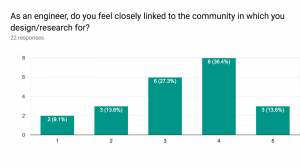
Figure 6. Faculty responses to “As an engineer, do you feel closely linked to the community in which you design/research for?.” This figure displays the strength of Lafayette engineering faculty’s connection with the community they design for.
The following responses to an open-ended follow up question to the above questions show a generally positive reasoning for their responses:
- “I do projects with and for the community, based on collaboration with members of the areas of relevance.”
- “I feel it is my obligation to find solutions that impact the global and local communities however sometimes in research and teaching it feels a bit far removed.”
- “My previous two answers were predicated on me doing community-centric design. I believe that engineers doing that work should be closely connected to the community in order to have a strong impact. However, that is just not a focus of my teaching or scholarship.”
- “My responses would depend on how one defines “community.” My design work does not impact the general public. It impacts the client. So, neutral responses were given.”
The above responses portray a general understanding of community in a general sense. Faculty acknowledge the significance of community within engineering even though their work is not directly connected to communities. Their critical considerations of these questions were evident through questioning the definition of community and strong statements explaining their positions. One response illustrated the distinct view they have about their definition of and interaction with “community.” This professor stated, “ I reject tribalism and condescension and elitist hubris.” The interpretation of this response can be inferred through their responses in the survey. Considering their responses to the survey, their engagement with community is minimal, if not, insignificant to their identity as an engineering professor. This may explain their view of community as an underdeveloped arrogant term. Although their colleagues mainly shared positive support of community engagement, this professor challenged that idea and voiced an unpopular opinion.
In the non-technical skills portion of the survey, most faculty were more responsive and familiar with the topic. When asked to identify the top three non-technical skills they focus on implementing in their courses, the most commonly mentioned skills were writing and communication in various contexts. These focuses show that engineering students are encouraged to develop the professional skills necessary in the corporate setting. The community-oriented skills mentioned the least were understanding contexts, empathy, engineering ethics and self-motivation. These are competences that are uncommonly highlighted within engineering curriculum but as equally important to the traditional non-technical skills popularly mentioned.
In the last three questions of the survey, faculty responses reflected stronger connections with the implementation of non-technical skills. When asked how they teach non-technical skills in their classes, all professors selected “in projects.” Following this method, “in assignments” received 68% of votes, “through lecture” followed with 50 % of votes, “in homework” with 50% of votes and “other” with the least amount of votes at 18%. These results are displayed in Figure 7. Those who selected “other” included presentations and laboratories in the explanation section. These responses show that interactive tasks like projects and presentations allow students to explore and develop their non-technical skills better than other forms of evaluation. Projects are flexible and multidisciplinary facets of showing students the engineering design process.
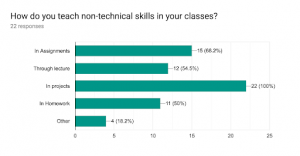
Figure 7. Faculty responses to “How do you teach non-technical skills in your classes?.” This figure displays the distribution of the methods in which non-technical skills are incorporated into existing classes.
The next question, “When students are conducting group work/projects, how would you rank the importance of non-technical skills implemented during the process?,” received ranking mainly between four (4) and five (5), as seen in Figure 8. 95% of respondents ranked non-technical skills as either important or extremely important. Considering this high positive response, professors understand the relevance of developing these skills for students’ professional careers. Lastly, 85% of faculty selected their emphasis on “professional” ABET skills in their classes between a three (3) and five (5). This question shows professors’ competence in ABET criteria and active implementation of these skills. The following graph shows the results of the importance of non-technical skills.
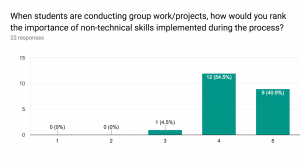
Figure 8. Faculty responses to “When students are conducting group work/projects, how would you rank the importance of non-technical skills implemented during the process?.” This figure displays professors’ perception of non-technical skill development.
ME 497: Community Engaged Senior Design Project
In addition to formal surveys, our team analysed engineering culture at Lafayette through observational analysis of a 400-level mechanical engineering senior design course. This course includes a “multidisciplinary team of engineers – in a Community Engaged Scholarship senior design project”(R. Koh, personal communication, April 8, 2018). This course aims to combine skill sets associated with “(1) working on a multidisciplinary team, (2) working with community partners, and (3) centering societal impact in the selection of our design problem” (R. Koh, personal communication, April 8, 2018). These principles aligned with community-centric engineering practices, however, as two of our team members participated in this course, we have a more in depth understanding of how these practices and principles played out during the course. Our team members (Ava and Fanessa) observed a general gap in understanding the difference between the design process of a community engaged project and a standard engineering project.
During the first week of the course, Professor Koh assigned readings about shifting the traditional engineering perspective such as, Engineering to Help: The Value of Critique in Engineering Service (2009) with the goal to establish a base from which to work off of during the design process. Class reflections were focused on thoughts about the article reading and common stereotypes of engineers. Based on these reflections, B.S. engineering students were in agreement with the idea of “engineering to help” but participated more when sharing common stories and jokes about engineers than when discussing sustainable community design.
For the first five weeks of the semester, the group struggled to balance between problem generation and stakeholder outreach. Most B.S. engineers in the group were greater advocates for identifying a problem and solution before conducting a thorough amount of interviews. For example, a few students wanted to identify an interesting problem based on the team’s interest and then identify stakeholders to support this project. Other students challenged this idea by emphasizing the definition of sustainable community development (SCD) and the problems associated with these students’ perspectives on community engaged engineering work.
Throughout the semester, the team faced a few recurring challenges such as a disproportionate ratio between mechanical and non-mechanical engineering students, difficulty communicating as a group, overpowering solution driven work and a tendency to frame the community as a secondary focus. Since this is a mechanical engineering senior design project, the project team consists of a greater number of mechanical engineers than civil engineering and Engineering Studies majors. The ratio is four non-mechanical to eleven mechanical students. The team’s overall difficulty communicating was reflected in the process of writing design proposal reviews. In the drafting of the reports, there was greater written bias towards a “solution,” grammatical and structural errors as well as challenging writing sequencing (not clearly structured). During weekly team meetings, project discussions were geared toward solution generation and design planning. An overall view of community as a secondary focus of the project was made known through conversations during team meetings surrounding community affordability, a focus on product development, and project metrics. Conversations about project feasibility and metrics led to members worrying about “the affordability constraint limiting the creative process,” preference for a consumer product for market sales over a public or infrastructure-based product. Teammates held novelty as a central focus rather than community. The team’s focus on profit marketability and novelty shows there is a gap between engineers’ personal definitions of their roles and society’s definition of the role of engineers as community agents.
These observations of the Community Engaged Senior Design Project show that there is a gap in engineering education’s relationship with community. Aside from the surveys’ direct confrontation of the role of community in engineering, this capstone engineering design course provides insight into the mindset of a Lafayette mechanical engineering student’s understanding and values placement of community within the engineering context. From these analyses, we conclude that integrating a community-centric engineering course into the Lafayette engineering curriculum would further students’ understanding of their role as aspiring engineers in society.
Ethical Scope:
Engineering ethics entails “the study of the moral issues and decisions confronting individuals and organizations engaged in engineering” and the “study of related questions about the moral ideals, characters, policies, and relationships of people and corporations involved in technological activity” (Martin & Schinzinger, 1983, 3). Engineering ethical practices combine the applications of “engineering and society” and “culture and technology” in a way that puts practice and application to the identified societal issues, as described in our social analysis. Engineering ethics addresses the connection between engineering and society in terms of aligning engineers’ jobs with societal needs and the need to reclaim their role as social agents. Additionally, it connects culture and technology by addressing the need to create technology with cultural concerns in mind. We used the analyses of ethical practices to understand what engineers tangibly need to change to best fit the wants and needs of the community at hand, and to stray from societal norms of engineers. As ethics include the “justif[ication] of moral judgments,” our team identified the necessity for engineers to understand ethics to best assess and design for communities (Martin & Schinzinger, 1983, 3). We used this research to understand the necessary components of our course, and to ultimately determine that we should dedicate a large section of this course to teaching ethical practices.
In comparing the ethics behind engineering and social work, Shuman reminds engineering educators that “if the vision for understanding ethical and professional responsibilities as articulated in ABET is to become reality, educators must now answer a number of questions: What is appropriate content? What teaching methods and curriculum is preferred?” (Shuman, 2005, 46). We used these practices to understand what necessary lessons and practices to include in our course curriculum. Our course aims to embody a “well designed course in professional ethics [that] may well contribute something to the ethical development of students, at least in making them aware that technical choices have implications for the basic needs and legitimate expectations of others” (Kirkman, FU, & Lee, 2017, 1). This course will focus on the ethics of SCD, ethical concerns in more corporate-based design applications, and the ultimate redefining of the engineer as a social agent through ethical practices.
Since student run projects regularly reflect the disconnect between engineers and the communities that they design for, ethical principles in engineering apply to student approaches and the execution of SCD (Lucena et. al, 2010). Teaching ethical values can increase student and professor interest in the development of non-technical skills, and effectively work as social agents. A curricular realignment with ethical practices is timely because the ABET criteria calls for more attention towards professional skills (Shuman, 2005). The ABET criteria that Shuman discussed in 2005, “call[s] for ensuring understanding rather than demonstrating that graduates are ethical… students should be evaluated on knowledge and skill, not values and beliefs,” therefore pointing our curriculum in the direction of theoretical ethics explanations, rather than jumping into action based projects without student mastery of an analytical background (Shuman, 2005, 46). A class which explicitly focuses on “social justice, equality, work humanisation, and the principles of sustainable development,” rather than subsequently focusing on these lessons can help Lafayette in training well rounded and highly marketable engineers (Gilbert et al., 2015, 6).
The relevance of ethics does not shift when focusing beyond strictly SCD and humanitarian design in engineering into general engineering problem solving. The technical skills currently emphasized in engineering education remain critical in training. However, an additional focus on “human centered approach[es] and user centered approach[es]” in education broaden non-technical skills to all subsets of engineering, not just humanitarian (Walter, 2005). These “human-centered” approaches place stakeholder and community wants and needs as central to design, and these lessons apply to all design contexts (Walther, 2005). Our course aims to train engineers to centralize community needs, regardless of the type of community.
While ethics may not appear explicitly in traditional engineering problem solving, they can qualitatively measure efficiency in design implementation and community or client acceptance. An understanding of engineering ethics practices amongst engineering students would mitigate the continuation of the historical lead up to present day engineering culture. Ethical conversations touch on the fact that in engineering design “there will be times when [engineers’] activities will ultimately lead to a product that is unsafe or less than useful” as a result of “ [intention], [pressure], or in ignorance”(Martin & Schinzinger, 1996, 6). The current cultural framework surrounding engineering education enforces the notion that “any non-technical concerns such as public welfare are irrelevant to real engineering work,” however, empathetic design could mitigate this assumption (Walther, 2005). A knowledge of engineering ethics enforces the sentiment and, more importantly, the skills that reverse this mindset and its lasting effects by acknowledging that empathetic design is necessary beyond explicitly SCD projects (Walther, 2005). Instead of continuing in the technologically determinant path of Engineering Problem Solving methods , “an understanding of how the growing social consciousness around the world is making it imperative that engineering students understand the implications of their work” would help to train more well rounded and holistically trained engineers (Shuman, 2005). Engineering students can develop these user-centric design approaches in empirical ways and empathetic ways, all while considering human factors as a subset of engineering ethics.
In reviewing the history of engineering, our team has drawn a connection to issues in contemporary engineering culture. This culture has become deeply ingrained in the definition, productivity, and expectations of the 21st century engineer, however, it also leaves gaps in efficiency and sustainability. Martin and Schinzinger explain that ethics should be analyzed on both micro and macro levels, including everyday ethical questions, as well as larger, societal questions. They suggest that “we need ongoing attention to both, and a scrutiny of how one may affect the other in an engineer’s professional and personal life.” Therefore, our curriculum aims to teach students this societal awareness (Martin & Schinzinger, 1983, 5).
Ethical practices in engineering aim to tackle the long existing gap between engineers and society, which alludes to this lack of sufficient productivity. Both nationally and within Lafayette’s borders, engineering education reflects the technical values of contemporary engineering culture. While technical skills remain important, ethical principles guide our curriculum in that “[engineering education] calls for a suite of cognitive skills associated with moral imagination” (Kirkman et al. 2017, 6). Through our proposed curriculum, our team diverges from this trend and hopes to help Lafayette train well rounded and uniquely marketable engineers.
Curriculum Proposal:
Our team’s research and outreach process led us to the ultimate proposal of a semester long, 200-level engineering course, based in the principles of SCD and engineering ethics. The first half of the course primarily provides lessons specific to SCD, because a community-centric course relates most explicitly to SCD. As our team believes that these principals benefit engineers in all fields, the second half of this course then expands these lessons to more traditional, consumer-minded, engineering practices through an introduction to engineering ethics.
Our team suggests that this class be open to all Engineering divisions as a general engineering elective. This course will gain traction if it were additionally cross listed as a 200-level Engineering Studies course. Currently, the Engineering Studies capstone course is organized in two sections: the first part of the course teaches SCD and historical engineering perspectives for the first five to six weeks in a purely analytical perspective and transitions into student led community-centric engineering projects. The incorporation of a 200-level community-centric course would alleviate capstone courses from both teaching these principals and applying these lessons. Our proposed course would thoroughly teach the ethical practices needed to lead community-centric projects and provide the capstone course with five to six additional weeks for project work. This course is designed to lay a groundwork of an ethical mindset and knowledge base so that “outcomes associated with ethical responsibility might be taken up in a stand-alone course in ethics and in core engineering courses and in the capstone design course, just as other professional skills might be integrated into what is otherwise a stand-alone ethics course” (Kirkman et. al, 2017, 1). In these additional weeks, capstone students could develop deeper relationships with their respective communities and more comprehensively apply non-technical skills. This course would provide the background knowledge necessary for students to participate effectively in experientially-based capstone projects, specifically in Engineering Studies.
The SCD-focused first half of this course starts with a brief history of engineering. Students will read Engineers for Change as the central reading for this portion of the class (Wisnioski, 2012). From the historical background, students will dive into an analysis of engineering culture, practices, and contemporary approaches, as to understand the current gaps between engineers and society. The course analyses engineering culture early on so that engineering students best understand the gap in skills left by contemporary engineering culture, and the necessity to fill this gap. In this portion course, students will have the opportunity to also read Engineering and Sustainable Community Development as a second keystone reading (Lucena et. al, 2010). This book not only outlines principals specific to SCD, but also reviews multiple SCD case studies. Many of these case studies are flawed in execution, due to the technical emphasis of engineering skills, and will help students begin to understand the do’s and don’t of SCD (Lucena et. al, 2010).
The second half of the course focuses on engineering ethics in both SCD settings and in more consumer-based, professional engineering settings. The engineering ethics portion of this class also provides a brief introduction into human factors practices, as these practices relate to community engagement in an empirical way and in a context outside of strictly the SCD application. A review of engineering ethics will further students’ understanding of engineering culture in terms of existing sociotechnical systems. Kirkman notes that “navigating non-trivial problems in ethics and in design calls for more than static judgment, mechanical procedures or simple decision rules. Rather, it calls for a suite of cognitive skills associated with moral imagination” (Kirkman et. al., 2017, 3). This course aims to infiltrate students’ mindsets in a way that explains the importance of ethics and community-based perspectives in any engineering project. Table 1 shows a potential fifteen-week schedule for our proposed course.
Table 1: Potential Course Schedule
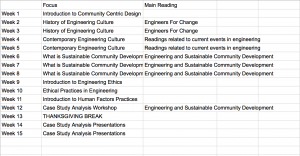
Table 1. Potential fifteen-week schedule for proposed course. This table outlines the potential chronological course structure.
Students will learn how engineering culture currently restricts engineers from engaging adequately with the communities they design for, and how this can be detrimental to efficiency and longevity of engineering projects. The non-technical skill set that aligns with engineering ethics practices will help students understand their professional and ethical responsibilities. Through reading literature about ethics, reviewing case studies, and reading about useful practices, “students can become more aware of the ethical implications of their work, they can learn ethical standards, they can become better judges of ethical conduct, and they can become more willing to put their ethical knowledge into action” (Shuman, 2005, 5). Our team believes that engaging students with a community-centric skillset in the context of a seminar-based, reading and writing intensive course will lead to a thoroughly formative understanding of the ethical practices necessary for experiential community-centric projects in the future.
Whether this future “community” entails an underprivileged community or a private client, this added skill set can increase efficiency in their work. This course provides students with a background of knowledge, which will advance their skills in “understanding rather than demonstrating that [engineering students] graduates are ethical” (Shuman, 2005, 5). This provides an opportunity in this course to “evaluate [students’] on knowledge and skills, not values and beliefs” (Shuman, 2005, 5). The engineering ethics portion of this class will also provide a brief introduction into human factors practices, as these practices relate to community engagement outside of the SCD application.
In order to thoroughly teach students the necessity of community engagement in SCD and other design settings, students will analyse case studies as a final project. Engineering and Sustainable Community Development discusses a plethora of case studies, each with unique flaws. A cumulative project which analyses such case studies in a literature-based format will better prepare engineering students for capstone courses. It applies the lessons gained in this literature-based class. Students will “effectively used case studies to teach not only design, but ethics,” as well (Shuman, 2015, p. 6). By picking out flaws, strengths, and providing better techniques in community engagement in these case studies, students will be better prepared for future opportunities when working with communities.
Class Structure and Course Description:
In the political section of this report, we mentioned the Colorado School of Mines (CSM) as one of the leading engineering institutions pursuing sustainable community-centric design education. Specifically, CSM has two unique minor programs that teach their students about this type of design. The first program is a minor in engineering and community development (ECD).The goal of ECD is to prepare students to become leaders in community development through engineering. This minor prepares students to work within the field of humanitarian engineering. Leadership in Social Responsibility (LSR) is the second minor at CSM that helps graduates understand the integration of engineering into the real world. The LSR minor focuses more on social responsibility within a corporate organization (“Engineering….Society”, 2017).
Both minors and the courses required to fulfill the minor are listed on the CSM website. We read through the course descriptions to become familiar with the type of courses these minors entail. For this project, we knew that we would have to develop a course description as well as learning outcomes for the proposed course. In Table 2 are a few of the course descriptions from CSM. These course descriptions detail some goals and outcomes for the classes within the ECD and LSR minors.

Table 2. Course descriptions from CSM’s ECD and LSR minors (“Engineering….Society”, 2017). This table details the important concepts and ideals that CSM instills in their students.
The CSM course descriptions helped us gain a better understanding of the types of concepts and ideas we should be pushing for in a course that helps students better understand community-centric design. Pairing our knowledge from the literature reviews and the course descriptions, we were able to distinguish important phrases and themes from CSM’s courses that we want to include within our 200-level course. First, understanding the concept of sustainable community development is crucial to the courses at CSM and likewise will be integral to the core of our course development. In order to understand sustainable community development, students need to understand that context matters. Engineers’ thorough consideration and integration of historical, political, economic, social, and cultural perspectives into their solutions will deem development sustainable. CSM highlights the importance of social responsibility within the course descriptions. The ability to understand the wants and needs of stakeholders is another important aspect that we want to incorporate within our course. These stakeholders can vary from investors, end-users, coworkers, and many other types of people. Part of the purpose of our
course is to help educate engineers on the different types of stakeholders and develop an understanding of how stakeholders can take different forms depending on the type of project. It is also important for our engineers to understand that the weight each stakeholder has varies on the conditions of the project.
Another key component of sustainable design that CSM’s courses outlines are students understanding the impact that technology has on communities and end-product users. This is an important concept that we have touched upon in our capstone class throughout the semester. Our goal for the students of this course is for them to understand the impact of their work beyond just the technical. We want students to understand how their work impacts people in communities. CSM also has a course description that explains how they approach teaching engineering ethics. The CSM class first shows the students the engineering code of conduct and explains ethics with regards to engineering on a personal level. However, then the course focuses on macro ethical issues which entails the collective social responsibility of the engineering profession. For our specific class, we feel that focusing on macro ethical concepts will help us integrate the concept of engineering ethics and impact of technology which will help engineers think more holistically about the products that they are designing.
Based on our research, our course description is as follows:
This course focuses on the development of non-technical skills amongst engineering students. Students will use seminar-based discussions, reading, and writing to better understand the integration of engineering projects into society by incorporating historical, political, economic, social, and cultural contexts. Students will understand stakeholder perspectives, their needs, and their participation in the engineering design process. This course is divided into two main sections: an analysis of sustainable community development and an analysis of engineering ethics. Students will learn how to take this community-centric skill set and later apply it to their future academic and professional careers.
Accreditation and Course Outcomes
When speaking with professors about the creation of this course, it was mentioned that it might be hard to get faculty on board. The course is not easily ABET accredited due to the completely non-technical emphasis that the course will have. Through literature reviews on courses that revolve around sustainable community design and engineering ethics, there are certain ABET criteria that can be met by this type of class. The outcomes that this course would fulfill under criterion 3 of ABET are listed below:
- An ability to design a system, component, or process to meet desired needs within realistic constraints such as economic, environmental, social, political, ethical, health and safety, manufacturability, and sustainability;
• An ability to function on multidisciplinary teams;
• An ability to identify, formulate, and solve engineering problems;
• An understanding of professional and ethical responsibility;
• An ability to communicate effectively;
• A broad education necessary to understand the impact of engineering solutions in a global, economic, environmental, and societal context; and
• An ability to use the techniques, skills, and modern engineering tools necessary for engineering practice. (Amadei, 2010, 87)
The hope for our course is to help strengthen education that occurs within these categories of ABET accreditation at Lafayette College. The first criterion above alludes to the ability to design a system with realistic constraints. An important point to note is that engineering is made up of important non-technical constraints and contexts such as historical, political, social, safety, etc. This course would help train our engineers to think outside the box and understand that context does matter with regards to engineering projects. The second focuses on being able to work on multidisciplinary teams. Once this course is taken off the ground, one of our hopes is that engineers from different disciplines will be enrolled in this course. This would include engineers from the BS program but also students from EGRS. This will allow engineers to understand different perspectives and different experiences that other students have had during their time at Lafayette.
The third criterion listed above details the ability to identify and formulate engineering problems. This course will help engineers approach problems from more than one perspective. It will teach students to think about engineering from an interdisciplinary mindset rather than just a technical mindset. In turn, our hope is that this will allow engineers to better understand problem identification and also become better solvers because they will think more holistically. The next criterion touches on the ethical responsibility that engineers will learn. Our proposed course will have a full section on engineering ethics and the social responsibility that engineers hold in their profession. We strongly believe that this course will help enrich this criterion because, based on current feedback from students, engineering ethics is glossed over in the current curriculum, especially those from civil engineering. The fourth criterion focuses on understanding the impact of engineering solutions in a well-rounded scope rather than just focusing on the technical aspects. In our course description, we plan on showing how engineering has interdisciplinary impacts on different stakeholders within the project as well as society. The last criterion details that engineers should have the ability to use techniques, skills, and tools for engineering practice. This course will equip our students with the ability to approach engineering through different perspectives. In addition, this course will challenge students to think about engineering in a completely different way than what they are used to, as this course will have minimal technical aspects to it. These skills will carry with the students as they advance in their educational and professional careers. In our previous sections of this report, we see that this course will change and benefit the way in which students approach solving engineering problems.
Thinking about this course within the context of ABET accreditation has helped us formulate our learning outcomes for the class. These learning outcomes expand upon the course description and will help future EGRS capstone students and faculty design a syllabus to go alongside with the work that we have done thus far. These outcomes paired with the understanding of the specific ABET criteria listed above will give this class the credibility it deserves within the engineering department at Lafayette.
Our Specific Learning Outcomes:
By the end of the course, students should be able to:
- Identify and analyze the contexts in which engineering and technology are built in.
- Recognize how these contexts influence engineering and how engineering impacts these contexts
- Recognize the different ways in which to approach an engineering problem
- See both the strengths and weaknesses to Engineering Problems Solving
- Be able to discuss and write about sustainable community development (SCD)
- Understand different perspectives of community members and end-users as well as stakeholders throughout the design process
- Understand how SCD and macro ethics interact with one another
- Analyze recent case studies
- Analyze the important non-technical skills associated with understanding and solving engineering problems
Through our literature review and outreach process, our team believes that our proposed course with the above learning outcomes has the potential to sufficiently provide Lafayette engineering students with an introduction into community-centric design. As Lafayette enters a potential new stage of reform, this course can kick start Lafayette’s new wave of holistic engineering.
To read the conclusion of our report click here